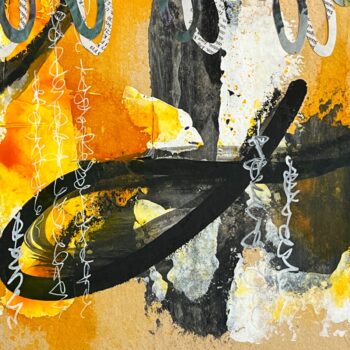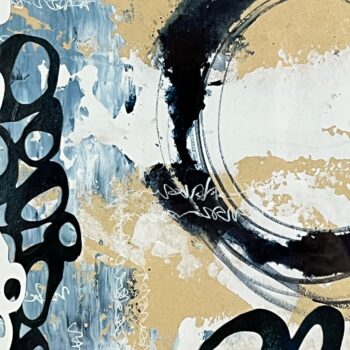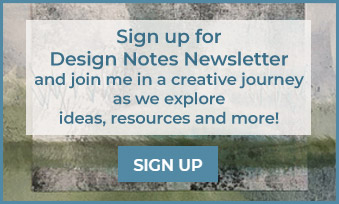


The reason why we are alive
is to express ourselves in the world.
And creating art may be the most
beautiful and effective method of doing so.
Rick Rubin: The Creative Act- a Way of Being
Hello Everyone and Welcome....
Just a couple items before we start...as this is the fourth time for the Artists Deep Dive, throughout the weeks, you will see me in different outfits, different clothing styles, more or less grey hair! I have used some previous video, edited more of it and inserted more content, just in case you are wondering! LOL
I will always send out a reminder about the Zoom Meetings - but just in case...its always the same link:
Zoom Meetings:
Join Zoom Meeting
https://us02web.zoom.us/j/3992397526?pwd=anZNR3IzUHdjSUdKcWNjOTJFTE5oQT09
Meeting ID: 399 239 7526
Passcode: 629407
You probably have a few ideas on what your six weeks of the Artists Deep Dive might look like, perhaps you have started a plan, done some writing or drawing and you are excited getting started. Great! This week is a bit like the first week of school, getting settled in, meeting new friends and learning about your courses - yeah, remember school? Well, this is also better, as you are both the student and the teacher, you are planning your own curriculum - when to take lunch breaks and how much homework - it's up to you.
At first it might all feel it little muddly - too much information, too little information, wandering in circles, and not knowing just where to start. So I'm going to walk you through a few steps to get you started - we'll talk more during the Zoom calls and if you have questions at any point, please reach out - I'm just an email away.
I'd like you to follow along with these first steps, read and watch the videos, read a bit more, go back if you like, make notes, have a coffee and maybe a bit of chocolate....
Your first step this week is to create a Mind Map, putting everything you can possibly think of that is related to your residency down on paper, brain to hand to paper to eye makes ideas real. Instead of them swirling around in your brain, they take form and are "real". I find Mind Maps incredibly helpful and use them quite often , especially when faced with many ideas and choices. They capture those ideas, sort them, rank and categorize them and show relationships among those ideas.
I think it is vital to create your Mind Map by hand rather than digitally. When you do things by hand, there’s a connection formed within your brain. This connection is what helps you to remember because you have to slow down and really think about what you’re writing. Doing so, signals to your brain that the information your wrote down is important.
Why make a Mind Map? It's a reference tool but more importantly, its a "brain dump", giving clarity to those half formed thoughts, moving them from your brain to the paper. You will also see the relative importance or unimportance of those thoughts! And all of this will help with your decision making through the month.
Use a big piece of paper, even tape several sheets together. Pull out the fancy pens and markers, place your main idea/concept in the centre and work out from there. Make branches of subideas and connections, working deeper into the details. One branch might begin with your supplies - fabric - then a sub-branch might list possible kinds of fabric: linen - hemp - blends - vintage. Another branch might list if the fabric is dyed or needs to be dyed...
Here are some other possible starts to your "branches":
- technique(s):
- mark making
- undercoats
- palette knife
- airbrush
- colour options
- spring palette
- only two primaries
- transparency/layering
Do you see how each choice leads to other choices and more choices? There are no limits to what you write or draw on this map - get it all down on the paper and then "paths" or focuses will reveal themselves to be the right ones for you....at this moment. Don't dismiss the ones "not chosen" as they may become important for you later on or be a reference for another focus at some point.
There is a theory that when one uses images rather than words there is more depth to the map - instead of writing "crown", draw a crown. I'm not sure I agree, but it might work for you.
Watch the videos below as I demonstrate how I make a Mind Map for my residency, the first is a general exploration and the second is deeper and more detailed.
Building a Mind Map - Part 1
Building a Mind Map - Part 2
So that Mind Map is a summary of what I began in January - I have adapted my work since then and completed some vessels, there is still much to be done and I probably didn't think it was such a monumental task as it is becoming!
But now is a different focus as I have just completed the work for a duo exhibition in January and I am going back to a theme that I had worked on earlier this year - making larger work for my Casco Vello series.
And an update for January 2025 - last year involved a lot of travel, including three different residencies in Greece, Sardinia and a small village near northern Vancouver Island. You might hear me refer to them during the Deep Dive. I'd like to add a couple notes about them:
- each was unique in their own ways, one with just three people, one with 8 and one solo. Each confirmed that my focus was important, that I was on the right path and they each provided unique insights into my ongoing series. They added richness and far more depth that I had expected.
-
diving deep into a single, focused area of our art allows us to uncover details and insights that might remain hidden when taking a broader approach. Somewhat like peeling an onion where each layer provides layers of complexity, interconnected patterns, previously unnoticed relationships, and a uniqueness to our approach.
-
- For example, during the first residency I spent time in museums and experimented with different vessels shapes, support structures and used a mixture of paper and fabric in my pieces.
- During the second, I was offered a fabulous book to aid my research into Goddess worship, which in turn gave me a wealth of symbols and imagery to incorporate.
- Finally, being on my own, I used materials to create larger pieces, learning what does and doesn't work with a few, limited amount of materials.
Each time, my focus evolved ever deeper and more revealing than before. I hope this will be your experience during the next six weeks.
If you would like some other resources for Mind Maps, I think these are quite good, although they lean more to the business side of art -
https://www.edrawmind.com/article/how-to-use-mind-map-for-art-creation.html
https://lorraineglessner.wordpress.com/2018/02/20/mindmapping-for-artists/
https://www.textileartist.org/bren-moody-on-mind-maps-and-sketchbooks/
Some artists create art that are mind maps or mind maps that are art...but we won't go there!
Do you feel that your chosen focus is too broad, even after making the Mind Map? Then take one of those "branches" and make a second Mind Map. Think about the "why" while you are working - "why would I do this", "why does it seems important to me", "why this choice - and not the other"
Does anything jump out at you? An unexpected twist that you didn't expect?
Just to illustrate a little further - I took this photo at an art museum in England https://www.saltsmill.org.uk/#

Consider all the possible ways of looking at this photo - it is full of complex imagery and details! Each of the details could become a focus for an in-depth exploration.
Shape:
- rectangles of windows and bricks
- lines of the vertical pipes
- circles of the faucets and dials
- lines of the radiator on the right
Colour:
- red, of course
- sandy/taupe of bricks
- off white of pipes
- gold of other pipes and radiator
Texture:
- smooth surface of pipes
- rough feel of the bricks
- cool surface of the windows
And I could also consider the light hitting different areas, the sounds that the water(?), gas(?) makes going through the pipes. Or perhaps the smells of the nearby bakery...I think you see what I see, the possibility of using just this photo for an entire month of exploring with different media, paints, paper, inks, dyes, pastes, collage, and on and on....This is part of what I think of as a "Deep Dive"!
A traditional art residency usually begins with your own research - where do you want to go, when and what will you do there? There are different levels of residencies, some are very prestigious with challenging acceptance criteria, others accept only certain focus - sculpture, photography, performing arts or similar. And others look for a broad range of visual artists, authors or music or screen writers - their goal might be to have an interesting mix of different and varied focus and age groups. But they all have an application process to follow. Most often the application would include the following:
- a Curriculm Vitae - a synopsis of training, education, exhibitions
- a Biography - where you live, work and a summary of your art practise
- a selection of images of your work, perhaps a link to video or writing
- and most importantly.....a summary of your intentions. These are usually just one page in length, specific in nature but flexible in execution.
So this is your next step: writing a Letter of Intention! You can keep this private but I may ask you to share some of it during out Zoom meeting? When applying to other residencies you are generally asked to keep this application/intention short....no more than one typed page. This is an important first step for the coming month. You won't know where you are going unless you make a plan - Here are some tips:
- talk a bit, a couple sentences, about your current art practise
- it might be helpful to title your residency...my Iceland residency was "Narrative"
- have fun with it - use your own writing style
- keep it flexible, begin with words like:
- I am curious about...
- I have always wanted to...
- it is time to...
- during my residency, I will...
- ....is important to me
Most importantly, say WHY...why are you curious, why is this the time, why is important to you? It doesn't need to be earth-shattering, profound or full of details but you will return to this page anytime you feel yourself sidetracked or wavering - it will help ground you!
This is different from an Artist Statement which is written after the art is created. This Intention is a general plan for the month - add sketches, thoughts, and ideas. And remember that you are not required to stick only to these intentions.
Here's some more of my ideas....
One of the residencies I applied to asked for only 1200 characters in the letter - that is not much and it challenged me to keep it brief and relevant, here's what I wrote:
Vessels - Art of the Feminine draws on my extensive experience in textiles and stitch. Inspired by a museum display of Greek vases and pots, I will build a series of vessels which follow the different stages of a woman’s life, infancy, through teen years, middle age matron and finally crone. These concepts are very much in the developmental stage with the willingness to follow paths to new ideas and attempt innovative and varied techniques.
In an effort to reduce my environmental impact, my supplies will be from less ecologically impactful sources, repurposed old linens, clothing or other recycled fabrics. And the addition of text in stitch and printing will be embroidered onto the surface of the vessels, creating a visual representation of the different stages of a woman's life.
We are constantly creating ourselves as works of art with the underlying theme of the female body/vessel as it ages from birth through to death through the lens of narrative and stitch.
I suggest that you keep your writing in the active voice - I will - not - I intend to, there is more strength in the active voice.
After building your Mind Map and writing your Intentions - you will see what is clear ahead - do you see some first steps and then some next steps. I am a list builder - it helps keep me on track and focused. It also keeps me from chasing "the bright, shiny objects"!
This is my approach when faced with a mountain - What are my three next steps?
-
-
- gather my essential supplies to get started - I will add to these supplies as needed
- get my journal/sketchbook ready to use (if I haven't already)
- clear a work area that is just for my residency - don't make this into a studio clean-up time
-
Here are some of my thoughts about my studio, workspace and supplies:
I hope this isn't total overload for you....take your time, the art comes first! We'll be talking a bit more about planning and prioritizing in the Zoom calls and the next couple weeks, in the meantime - go make art!



Resources - these are books, newsletters, podcasts and websites I have found useful or enjoyed. I like to create an ongoing list as we meet and perhaps you can offer suggestions.
BOOKS
Art & Fear: Observations on the Perils (and Rewards) of Artmaking by David Bayles and Ted Orland - I read and reread this book every year and always learn something or get a nugget of an idea.
NEWSLETTERS
https://www.themarginalian.org
This is a weekly newsletter filled with the week's most mind-broadening and heart-lifting reflections spanning art, science, poetry, philosophy, and other tendrils of our search for truth, beauty, meaning, and creative vitality (copied from the website) I am always moved by the writing and research that Maria Popova brings to her newsletters.
PODCASTS
Whichever platform you use, I find these on Spotify. I like to listen in while doing the mundane art tasks!
The Messy Studio with Rebecca Crowell: https://messystudio.fireside.fm
Just one more thing....
I think we all wear multiple hats in our lives - parent, spouse, business owner, employee, etc, etc....right? We have many demands on our time. But during the next six weeks, I'm asking you to make your art focus a major priority - you've paid money to be here and I want you to get your $$ worth.
In addition to my Morning Pages, I am a keen advocate of a daily/weekly planner of some sort. There are so many on the market, all touting to be the answer to organizing your life (there's a term for it: planner porn!) Just find one you like and do the following:
- Block off all your appointments and "have-to-do"
- Find those blocks of time - maybe 2-3 hours a day - and block those off for your art. They are precious and they are your priority for the Deep Dive
- Let everyone know that you are unavailable during those times - put the Do Not Disturb sign up
- See if you can track the hours spent creating and celebrate each moment!


